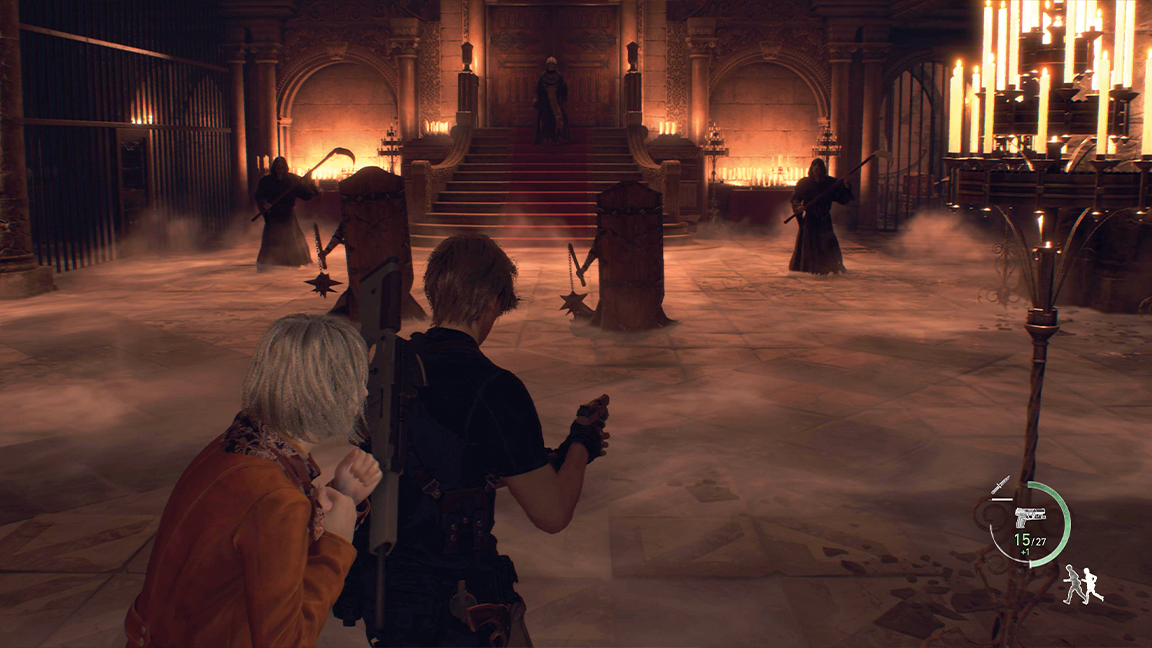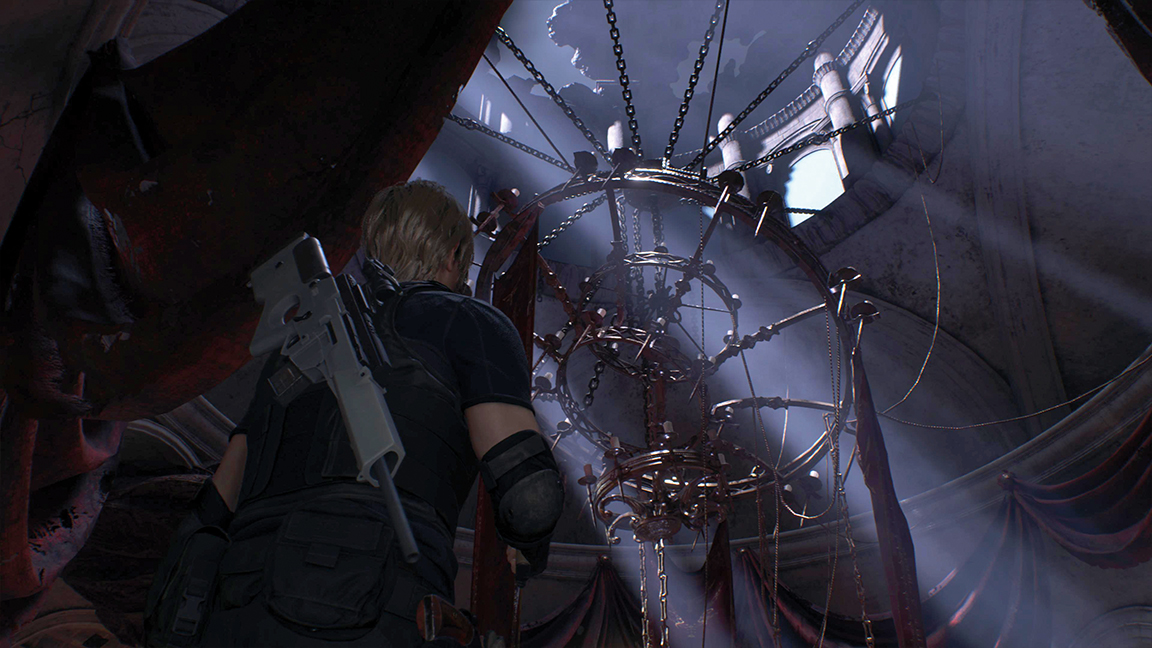Our Verdict
Resident Evil 4 on PS5 is one of video gaming’s greats risen from the grave, but without decay. What to tweak and what to keep has been smartly judged, with incredible action combat. The RE Engine is proving to be one of this gen's best and most adaptable too.
For
- A visually striking game on PS5
- Old is game design is reworked
- Lots of reasons to replay
Why you can trust Creative Bloq
Resident Evil 4 remade on PS5 and Xbox Series X is a work of art. Someone owes Marie Kondo a fruit basket, because this spring-clean remake of one of the best games ever made is all about sparking joy.
There are plenty of fantastic new additions, and the best bits aren’t just all present, but rearranged in a way that they complement each other more than they originally did, not least of all in how superstar secret agent Leon S Kennedy has been greased up to perform more slickly than ever. The definitive version of Resident Evil 4? Absolutely. The best game in the series? I’ll say it: yes. This is action-horror magic.
If you've not yet upgraded to a next-gen console then read our PlayStation 5 review for the lowdown on Sony's console and our Xbox Series X review to find out what's offered by Microsoft. We also compare the two in our PS5 versus Xbox Series X feature.

While the Resident Evil 4 story has undergone lots of tweaks in how it’s told and structured, the premise remains the same in this RE Engine remake. After surviving Raccoon City’s T-Virus zombie outbreak (and a stint in US Special Forces), Leon’s been drafted in as the US President’s number-one guy.
This means when the President's daughter, Ashley Graham, is abducted and held in a remote Spanish-inspired region of Europe, he’s first up the creek after her – sans paddle. If Leon had a blue medallion for every time he was involved in a completely different zombie-like outbreak, then he’d have two blue medallions.
Which is not a lot but it’s weird that it happens twice. Gone are the T-Virus shamblers, and in are Las Plagas, parasites infecting just about every living thing not nailed down and strung up in the village square. Chief among them, and giving Leon and his police escort an unfriendly and incredibly violent welcome to the backwater village, are Los Ganados.
Literally derived from ‘livestock’, these shambling enemies are the foot-soldier flock to creepy religious cult Los Illumanos, whose members worship Las Plagas, using them to further their own ends. Fortunately Leon’s on hand with a limited-slot briefcase full of guns, knives, herbs, and action-hero quips to get Ashley back – though they have a lengthy, harrowing adventure ahead of them.
Daily design news, reviews, how-tos and more, as picked by the editors.
Resident Evil 4 is a skilful adaptation

Just as the original 2005 version of Resident Evil 4 felt more responsive to control than its PS1 predecessors, the leap from that classic to this remake feels similarly revolutionary, not just in how much slicker and more deliberate every movement feels, but in what the floppy-haired agent can do. You feel the years of training he’s had since the events of Resident Evil 2 in how he plays, no longer the novice.
To match his skills, even the most basic forms of Los Ganados feel much more dangerous from the off, sporting an intelligence that regular zombies can’t match. They have a habit of coming down on you in large groups too, with all manner of improvised weapons (they’ll charge at you with pitchforks, throw axes, or simply try to wallop your noggin off with a scythe).
That’s before they call in their bigger mates or begin to transform, body-horror style, rising up swinging after taking a bullet between the eyes. Resident Evil 4’s constantly striking the balance between allowing you to feel in control and making you feel like you’re on your last legs, through deft deployment of a series of escalating, tense encounters that builds neatly throughout the lengthy campaign.

If the Resident Evil 4 remake’s success was balancing on a knife’s edge, then it’s a good thing it’s Leon who’s in control of that very blade. While knives and Resident Evil have always gone together as well as serrated edges and zombie flesh, a blade has never felt as core to your arsenal as it does here.
It’s an amazing mechanical addition that builds on the offensive and defensive capabilities the series has enjoyed to date. When you’re grabbed, a whack of R2 offers a way to cut a path out of a sticky situation, but you can also sneak up on unsuspecting enemies and take them out with one stab, or stun them before circling around to do much the same.
You can even tap L1 to whip your knife out for a parry. Hurled axe whirring your way? Parry it. Claw blades coming down? Again, parry. Buzzing chainsaw blade? Get it parried. This is all on top of always being able to swipe your blade out in front of you when not aiming a gun to get some extra licks of damage in.
Parry a regular attack at the perfect moment and you’ll briefly stagger an enemy, leaving them open for a melee strike with X, dishing out severe damage and sending them tumbling – ideally into a crowd of their friends. Downed enemies are open to even more knife action, and can be completely finished off that way. And when an enemy starts twitching, you really want to consider closing the distance to make use of that finisher, lest something more dreadful erupt from inside them to pull the corpse back into the fray.
The classic Resident Evil 4 is remade perfectly

It all builds on the fast-paced combat from the original game, where you could blast weak points to stun enemies before hitting them with a melee strike. That too is still very much the case. Where before the limbs you’d target felt satisfying to pop, there was a blockiness to the action that made things feel a bit gamey. Here, damaging limbs feels much more natural, and therefore more instinctive to exploit (curse the skirt-wearing enemies though, as it’s harder to accurately hit their legs).
Of course, as useful as it is, there’s a catch to busting out the blade. Your combat knife has durability that’s used up with each move, but can be repaired by the Merchant for a modest fee (though the weaker knives you pick up are irreparable and destroyed with use). It’s durable enough that you can use it to cull enemy numbers or get out of back-to-the-wall situations, but not hardwearing enough to allow you to spam it non-stop, and requires just enough skill to ensure it’s satisfying to use.
While simple to understand, combat’s deep enough to force you to think through your options and decide how you want to respond as you mix together ranged gunplay, melee attacks, and defensive knife manoeuvring. A mid-game fight, only a QTE-based cutscene in the original, now becomes a memorable boss encounter that sees you crossing blades for real thanks to the built-out knife mechanics. Where else can you feel immersed in a one-on-one knife-fight? It’s a refined loop that makes for compelling mixed-distance combat (tipping the cap to Resident Evil 6’s best moments) in an action-horror wrapper that becomes fun simply to play around in.
Combat shines in Resident Evil 4

Of course, the best fighting system in the world isn’t worth squat if it’s not deployed effectively. Interesting combat encounters and environment design were always Resident Evil 4’s mouldy bread and curdled butter, and it’s only become better here.
Leon’s even got a new mode of play: he can crouch-walk all over the place. While Resident Evil 4’s not really built around stealth, crouch-walking does mean you can be choosy about quite when you want to initiate a structured encounter, slinking off through alleys or behind shelves, perhaps taking a few enemies out from the shadows before it all hits the fan. It also means more quiet moments, the tension building naturally before baddies are unleashed on you.
One powerful enemy that relies on sound is even more thrilling to engage here as your crouch allows you to return more easily to being unnoticed, while this time there are more items in the area for you to accidentally rattle. Talk about tense.
The chainsaw-wielding Dr Salvador is more dynamic and dangerous, sealing off parts of the area to try to trap you
Though many of the game’s core areas – the village, the castle, and the island – have been reshuffled, it’s surprising how many encounters are structured in the same way as before, sometimes almost directly. Each part of the game has been approached cannily by the devs. For instance, fighting droves of Los Ganados on rickety walkways near the abandoned factory feels as overwhelming as ever, as does battling the castle cultists when they ambush you in the iconic water room – an event which plays out almost beat for beat.
Other encounters feel refreshed. Under siege in the bombastic village-set opening, you begin on familiar footing, but the chainsaw-wielding Dr Salvador is more dynamic and dangerous, sealing off parts of the area to try to trap you in a way that persists later in the game.

You can use tweaks to the environment to fight back, shooting down hanging lanterns to bring the heat or taking a tumble down a new well for a new avenue of escape. The same goes for a later cabin siege where you’re not only able to board up parts of the house to funnel enemies, but also have to contend with bull-maskwearing brutes who charge around with ruddy great big hammers. And don’t get us started on the camouflaged enemies introduced mid-game, who now rather than becoming semi-transparent actually blend in with nearby colours, looking like set dressing until they jump out to nab you.
The tone has been dialled down somewhat, but it’s surprising how tongue-in-cheek it remains (Leon still has plenty of one-liners), often helping to make the world of horror feel more grounded. You might not run from a huge rolling boulder any more, but the moment is still respectfully nodded towards, in that you have to avoid getting crushed in a different type of ambush, and later on there are huge balls of death that you do have to avoid (and then turn back on your foes).
Similarly, diminutive nemesis Salazar’s gigantic mechanical statue doesn’t chase you in a QTE sequence as before, but it still makes an appearance. Very few sequences have been cut entirely, but you won’t miss the ones that have been axed, as it’s all part of the much-improved streamlining, and there are more than enough entirely new bits to impress. That said, this is just a remake of the base game – don’t expect bonus content like Ada’s mini-campaign, though it could come down the line.
Game design has been refreshed in RE4

The result is a remake that feels a lot less artificially gamey than the original, but very much cut from the same cultist cloth. It’s most obvious in simply how the environments have been rearranged. Connections between environments have been made a lot less obviously corridor-like, with areas flowing much more smoothly into one another. It’s surprising how much these changes add to the sense of space, and improve the tone and atmosphere.
Gone is the random underground tunnel that connected the town hall to the church behind (yet it’s still respected thanks to the new, optional area entered via the well nearby); now, you move through a connected back garden and under a crumbling bridge before entering a hill packed with tombstones that rolls on up to the foreboding house of faith.
In the same way, parts of the village that once extended out to the forest have been rearranged to curve around the lake, giving you a better impression that the settlement is an actual place. Not only does it more pleasingly connect areas together, but it pays off in a chapter towards the end of the village section when, boat secured, you’re able to move back between some past areas to dock and uncover previously inaccessible pickups, now guarded by completely new, redesigned, more dangerous enemy encounters.
While all major areas shine because of the improved connections, it’s the village that feels like it benefits the most from a rejig to make it more open, while later areas feel more like linear zones with the odd backtracking shortcut.
Side-quests return, now with features beyond clearing out hanging blue medallion targets (though they’re still present). The stapled-up blue paper requests feel a little like collectibles themselves. The approach to side-quests is reminiscent of Resident Evil Village’s, though they involve fewer bespoke areas, often sending you back to previous areas to cull some wildlife or take on beefed-up versions of enemies. They give you a reason to explore, but aren’t revolutionary.
Resident Evil 4's RE Engine shines

Complementing the restructure are impressive visuals. While what’s accomplished with RE Engine boasts impressive levels of realism, the real impact comes from how it’s styled to emphasise the type of horror at play – the moon bounces off ruined roof tiles; the woods at night are properly dark; fountains of spilling blood and fleshy parasites ripping out of bodies glisten; and even smoke-machine-like fog collects and blows around the floor of the creepier lairs.
Almost everything here builds on what came before, taking it to new heights – and when it doesn’t, it presents what was already loved with an enhancing lick of paint. This is still a more action-packed, linear Resident Evil than, say, the second game (this is chapter-based), but it respects the source material while knowing when it needs to one-up it.
The boss fights are much better (some of the best in the series); Ashley is a better companion (and when you briefly play as her it has much more depth); and the structure hangs together far better both narratively and environmentally. Underpinning it all is a fantastic combat system that re-crowns Resident Evil as third-person action-horror royalty.
Just as importantly, the RE Engine is put through its paces and continues to impress. Capcom's own game engine is competing with the best around and proving to easily handle complex textures as well as steady frame rates, and there's the possibility of a VR mode – using the same RE Engine. Impressive.
This article first appeared in Play Magazine issue 26. You can subscribe to the print edition, digital version, or save even more with the print/digital bundle – whatever you choose, you’ll be receiving an unprecedented trove of dedicated PlayStation coverage every month.
out of 10
Resident Evil 4 on PS5 is one of video gaming’s greats risen from the grave, but without decay. What to tweak and what to keep has been smartly judged, with incredible action combat. The RE Engine is proving to be one of this gen's best and most adaptable too.

Games Editor on GamesRadar+ and former PLAY editor, Oscar Taylor-Kent first joined Official PlayStation Magazine in 2018, and was involved with the long-standing mag’s rebrand into PLAY before becoming editor. Despite being a PlayStation expert (and noted PS Vita apologist), he’s got fingers on many buttons, having also written for SFX, PC Gamer, Kotaku, Waypoint, Official Xbox Magazine, GamesMaster, PCGamesN, and Xbox to name but a few. When not knee deep in character action games, JRPGs, and visual novels, he’s often found reading books, manga, or binging anime. His current favourite games include Devil May Cry, Persona, Ace Attorney, and Hakuoki.

